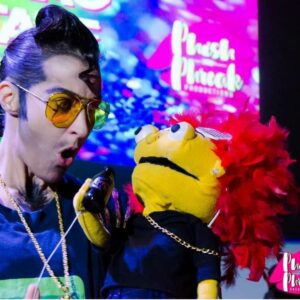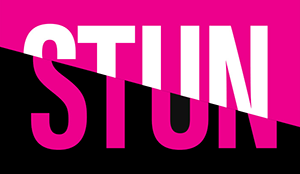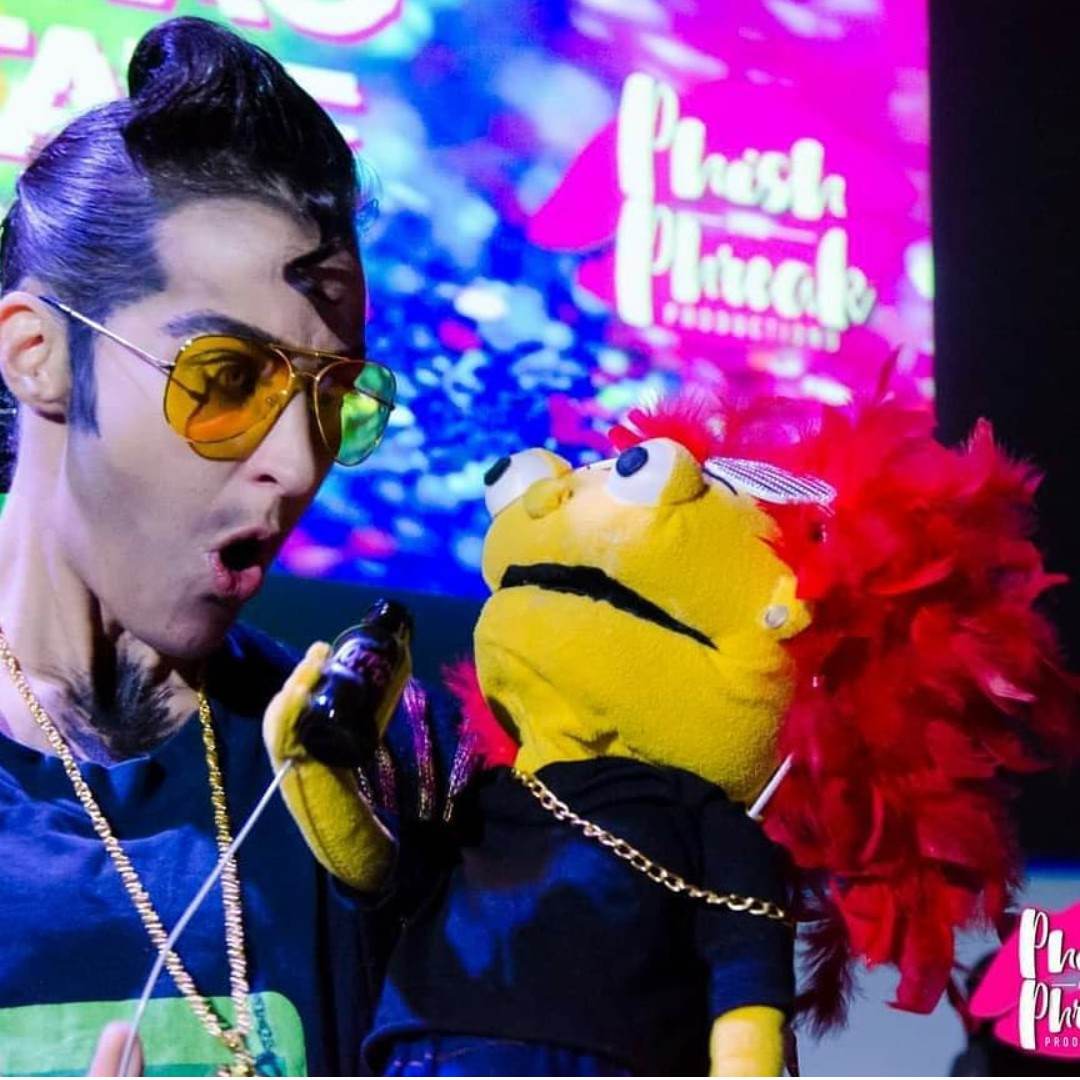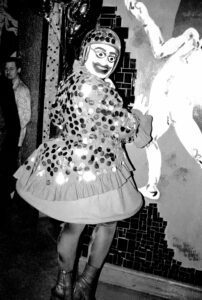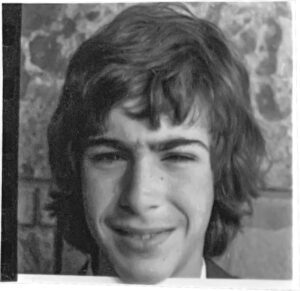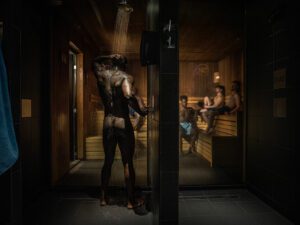After turning out a decomposing trash look, a Justin Bieber-inspired tantrum, and a glam ‘toodlyboop’ straight out of your nightmares, Zapp Backagain is Canberra’s So You Think You Can Drag winner. The puppeteer served all things weird at Phish and Phreak Production’s three-round drag competition late this year.
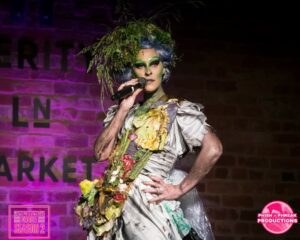
From the instant that Zapp Backagain waltzed onto the stage, the Canberra audience of public servants and university students were transfixed.
“I am Zapp Backagain. I am a 40 000 year-old cryptid that subverts expectations, highlights the weird, and transcends gender. My pronouns are “WHAT! WHY?” but I will also answer to they and them.”
Over the So You Think You Can Drag? competition, artists danced, lip synced, served looks, and shared their very special talents. It was that resurrected cryptid, with an aptitude for puppetry, that took out the crown.
Hannah Head spoke with Zapp Backagain about their drag.
Considering Zapp is 40 000 years old, what was the drag scene like when things first began?
When drag was first introduced to me, it was a huge club scene. Canberra’s drag scene lived and breathed in a club called Heaven. It was all a bit of a Wild West, with roughness and lawlessness about it. It was raves and lights and was always accompanied by an acceptance of people for who they are.
How did your passion for drag start?
I think like many drag artists, I started out as a theatre kid. I had always been a bit weird, and that definitely wasn’t celebrated in a Canberra Catholic school. It was around 15 that I stumbled onto the club scene and was adopted by some drag parents. I was at an age when I really needed someone to see me and it was such a big moment when I found this community that accepts and encourages authenticity.
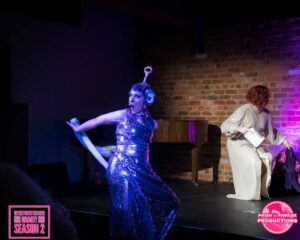
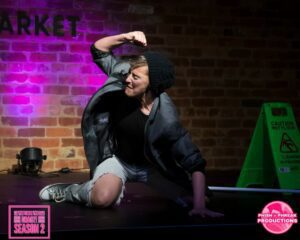
How did your family react to your love of drag?
They had no idea! I was too young to be going to clubs. I would have my parents drop me at the movie theatre, and I would get all dressed up and sprint to a show. I had no interest in alcohol or anything like that and back in those days, it wasn’t that hard to get into a club. Canberra is one of those places where everyone knows everyone, there were so many times that my siblings would be in the club, but I would have so much makeup on and be so dressed up that they wouldn’t recognise me. I would then run back to the movies, wash all my makeup off, be picked up by my parents and get back to Catholic schoolgirl life.
So you were leading a bit of a double life?
Yeah, I would go out dressed like a dweeb. I would rotate exploring gender, expression, and even the non-human through drag. Being a club kid was about pushing boundaries, and that is exactly what I did. But one day my drag parents moved, and Heaven closed down, and I needed to figure out my life. I was just coming out of college and I really felt the pressure of society to be something.
And what was that thing?
Someone with a comp-het norm-core life.
How did that life go?
Well, I ended up back in drag so that says a lot! But yes, I felt like I had to hide myself and conform to this idea of “normal”. Have the kids, be the mum, and do the family cycle. It wasn’t until I was in my sister’s bar years later that I was watching a drag performance and it all came back. I wanted to be on the stage. I missed the art form and suddenly understood how deeply I buried it. I wanted more weirdness, more ridiculousness.. just more. So I volunteered as a sacrifice, I was going to do a Frank Zappa drag performance, and my sister supported me. Her bar was an important space for Canberra’s drag scene, and it made me feel at home again.
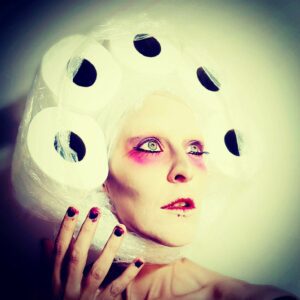
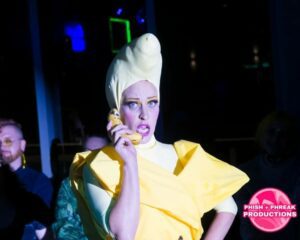
Weirdness is a really common theme for your drag, why do you think that is?
Another reason I ended up leaving drag was that I had a lot of health issues. I was diagnosed with epilepsy and was really struggling to control my seizures. I think I have weird neurology! Not everyone’s brain can just turn off or erase a memory! I had wonderland syndrome and medically diagnosed amnesia. When this is your day-to-day it all just feels normal, but I am sure it helps me conjure up my weirdness.
What has being back in drag whilst managing your health been like?
I just stick to the motto: keep on keeping on. My epilepsy is much better under control. The Canberra drag scene is also amazing with it all. They know not to use strobe or flashing lights during my set, and if I am scowling it probably means I am working through sensory overload.
You manage all of this whilst turning out some wild looks! What inspires your fashion?
Coming back to the drag scene I brought back with me some of that club-kid, but brought some of my background in clowning, comedy, and improv. All of these preach surprise and the unexpected, so I never really have a full plan of what will happen when I am in drag. This goes for my fashion as well. I am always cannibalising my costumes by taking ones I have worn, or am not inspired by, and making them into something even weirder. Often, like the case for the competition, I have to make something the day of because it is covered in rotting food.
Where do you find your artistic inspiration?
I take inspiration from dadaism and absurdism. I follow my worst possible impulse and slap it on stage, you know. Why not be a sparkle-covered demon tellytubbly? If I think it’s stupid, I will do it. I am lucky enough to have the support of my kids and my drag family too. They always take notes of whatever idea I blurt at them and help me to conceptualise it.
Why do you think audiences respond so well to Zapp’s absurdity?
It can be so humbling, To never know what will work it means you have to fling a lot of things at the wall and see what sticks. The unexpected really resonates with people. There is something so invigorating about not knowing what is going to happen. Even for me, since I have that background in improv, I never really know what I will do next. There is an energy exchange between performers and the audience. What you take on stage is what the audience will reciprocate, so if you are having fun out there so will they.
Speaking of the unexpected, your special talent involved puppeteering. How did you learn your way around a puppet?
I was always a weird kid, I came from a very creative family. My parents owned a video store. It was alternative and was filled with cult cinema, arthouse films, and a ton of instructional videos. In the 80’s the Muppets and Labyrinth were the rage. I found a VCR tutorial by Jim Henson on puppeteering and I was hooked! My grandfather was a signmaker, artist, and prop master. He always welcomed me into his studio and encouraged my interest! During COVID lockdown I decided to make a puppet again. I saw puppets as a way to extend a story or an emotion. They are fun, and silly, and who doesn’t love puppets?!
What advice do you have for drag artists looking for their own unexpected special talent?
There are no hard and fast rules to drag. You can be anything you want to be. If you want to be a banana do it! Your authenticity is your greatest asset. There is nothing you can do wrong, and there is no failure, it’s all art at the end of the day.
What is your take on the Canberra drag scene?
It’s always been so diverse. It is filled with all forms of drag, and all different people doing drag. It gives such a variety of concepts and ensures everyone in the drag space is valid and valued. I think the audience is different in Canberra. People are less reactive, so the element of surprise is really favoured.
Seeing you up on the stage in Phish and Phreak Production’s So You Think You Can Drag? event, something that really sat with me was how diverse the Canberra drag scene is. How do you think it compares to drag in the media?
When I started drag the entire art form was more diverse. Any gender, any sexuality, any person could do drag. I think drag became partly homogenised with the rise of RuPaul’s Drag Race. Suddenly, cis gay men were the only drag artists being seen. Canberra’s scene is incredibly diverse. I think seeking out different forms of media that highlight drag as a diverse art form is incredibly important. Watching a show like Dragula, something that validates all drag, and supporting local artists is super important to build up our community.
What advice do you have for those wanting to build inclusive drag spaces?
I think people should remember that art is for yourself. Drag shouldn’t feel like a chore. Showing your love and passion is something you should have pride in. The key thing is that your space is your space. It can be anything you decide it to be. So if you make a reality TV show and only have one type of queen on it then ok, but opening a space and putting no limitations will bring the best and most diverse drag.
So, what is next for Zapp?
I just take things as they come. I’ve got a cabaret, a holiday show, and a few different gigs coming up. For Zapp, they will continue to evolve organically, and probably keep getting weirder!
Editor’s note: Zapp will appear at Phish & Phreak, Drag Cabaret, Cabaret Voltaire and Everybody Loves Puppets in the new year. Yay!
